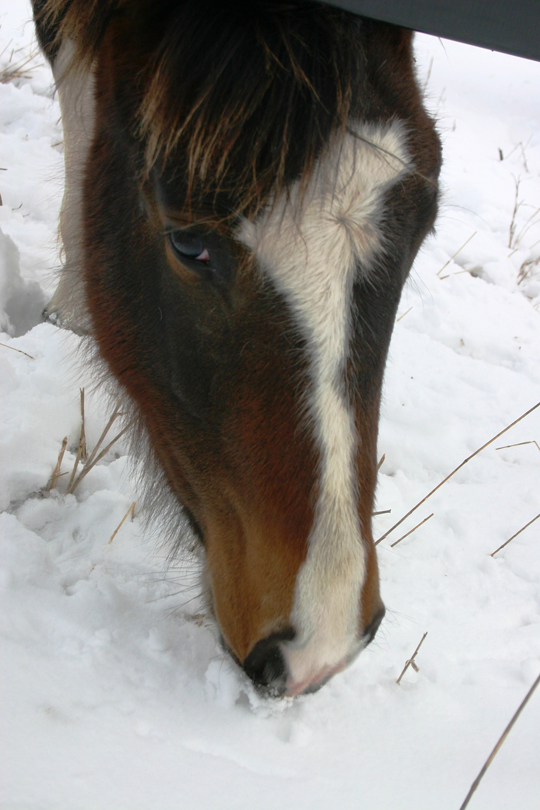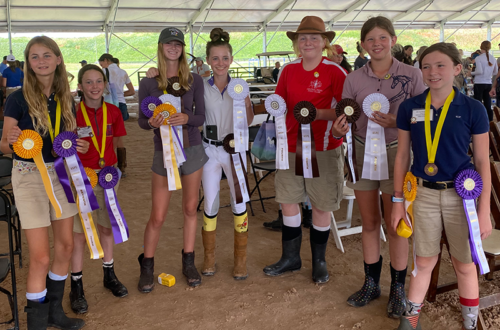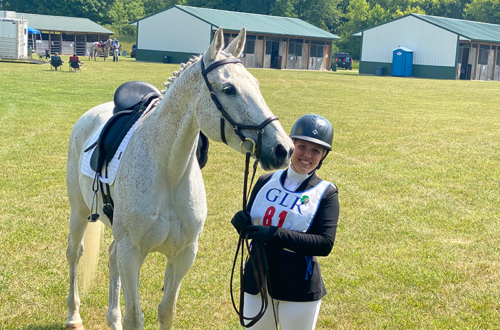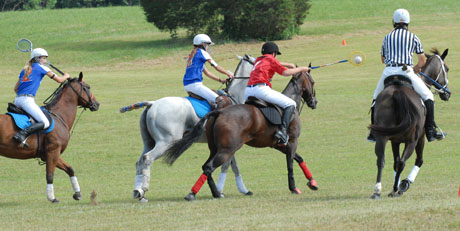
What is Polocrosse?

If you have seen Polo or played Lacrosse, imagine combining the two. This is very close to what Polocrosse is. Founded in Australia in 1939, it is known as the “King of the One Horse Sports.” (The Polocrosse Association of Australia, Inc.). And while it is wildly popular in Australia and most of Europe, Polocrosse is growing rapidly in the US. The American Polocrosse Association (APA) was formed in 1984 in Phoenix, Arizona. There are more than 44 clubs across the country as well as many Pony Club affiliations. It is one of the few team sports on horseback. Anyone who wants to play is welcome as there are levels for amateurs all the way up through professional player.
The Basics
To start, you only need ONE horse! This is not like polo where you need a string of at least 6. Like polo, any breed of horse is useable as long as they possess the will, stamina, and agility for the sport. A polocrosse racquet as well as a helmet are required for play for the rider and the horse must have leg wraps and bell boots on all four legs.
Teams consist of 3 players on the field for each “chukka” (inning). Most teams have 6 players so that they can rotate between chukkas. Usually a match consists of 4-6 chukkas at eight minutes each. Players are numbered 1-3. Player 1 is the goal scorer and plays primary offense. Player 2 is the middle or swing player as they play both offense and defense. Player 3’s main job is to play goalie. All are important to play and all have certain areas of the field they can and cannot ride in.
Equipment
Like lacrosse the ball is mostly carried, occasionally tossed to another player, but also must be bounced, so the ball is made of foam and rubber and is slightly larger than a softball. The racquets are mostly made of bamboo or a flexible fiberglass. The APA and Pony Club have slightly 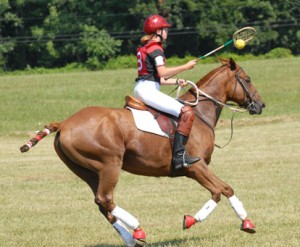 different rules on the size of the racquet head. Saddles are all purpose and a breastplate is required. Standing martingales are allowed, but any bit with a “protrusion” (aka a full cheek bit) are not. As stated before, boots or bandages on all four legs as well as bell boots on all four legs are required. Most riders wear white jeans or breeches and a polo shirt marked in bold with their number on it. Paddock boots or tall boots are mandatory and an approved helmet is required. Some professionals also wear knee guards (there is a lot of bumping around) and face masks although they are not required equipment.
different rules on the size of the racquet head. Saddles are all purpose and a breastplate is required. Standing martingales are allowed, but any bit with a “protrusion” (aka a full cheek bit) are not. As stated before, boots or bandages on all four legs as well as bell boots on all four legs are required. Most riders wear white jeans or breeches and a polo shirt marked in bold with their number on it. Paddock boots or tall boots are mandatory and an approved helmet is required. Some professionals also wear knee guards (there is a lot of bumping around) and face masks although they are not required equipment.
The Field of Play
The field is 160 yards long by 60 yards wide. To get an idea of how big that is, it’s bigger than a football field which is 120 yards long by 53 yards wide. (Authors note- It doesn’t feel that big when you are playing!) There is a penalty line that cannot be crossed by certain players (the #2 player mainly) at 30 yards from the goals and the goal area is 11 yards across. When crossing the penalty line the ball has to be thrown or bounced. It cannot be carried. The only players allowed in the goal area are the scorer (#1) and the goalie (#3 from opposing team).
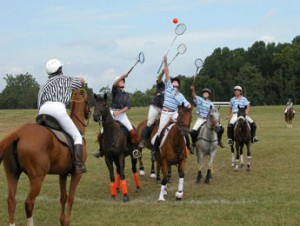
To start a chukka the players line up in two rows of three (#1 in front, followed by #2 then #3), center-field on the sideline facing the goalie, who is on horseback, sitting outside of the field. Players hold their racquets up high and the goalie throws the ball right down the center of the two lines. Whomever either catches the ball or gets to it first is in control.
A few standout rules
•A ball can be picked up from the ground with the racquet, thrown from one racquet to another or bounced on the ground. Hands are not allowed.
•When carrying the ball, the racquet cannot cross from one side of the horse to the other. So, if the rider is right handed, the racquet has to stay in the right hand, also the ball has to be carried on the right. The ball can be picked up or caught on the left but then the rider must cross it back to the “right” side.
•When striking another players racquet (AKA “giving wood”) to try to make them lose the ball, only upward strikes are allowed. Downward striking is hacking. Hacking is bad and will be penalized.
•Penalties do happen. Most of the time when a penalty occurs, a 10 yard throw is awarded to the opposing team.
So, if you like fast paced team sports on horseback this may be the sport for you. Polocrosse is easy, fun, and relatively inexpensive for an equine activity. There are even opportunities to do exchanges and compete overseas! For more information on Polocrosse in Pony Club, click HERE.
